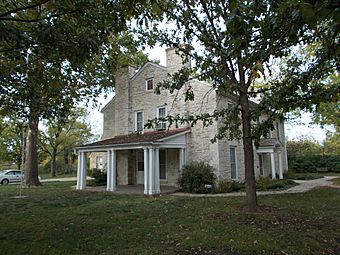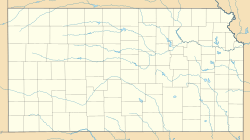Kaw Mission facts for kids
Quick facts for kids |
|
|
Old Kaw Mission
|
|

Kaw Mission Church in 2014
|
|
| Location | 500 N. Mission St., Council Grove, Kansas |
|---|---|
| Area | 4 acres (1.6 ha) |
| Built | 1851 |
| NRHP reference No. | 71000323 |
| Added to NRHP | March 24, 1971 |
The Kaw Mission is a special historic building in Council Grove, Kansas. From 1851 to 1854, it was a home, school, and church for about 30 boys from the Kaw tribe. This important site was added to the National Register of Historic Places in 1971.
Today, the Kansas Historical Society takes care of the mission. It is now called the Kaw Mission State Historic Site. Visitors can see items from the Kaw people and things used by pioneers in the mid-1800s.
The state of Kansas is actually named after the Kaw (also known as Kansa) people. They lived in this area for many generations. Later, they were moved to the Neosho Valley. Despite a strong request from their leader, Chief Allegawaho, the U.S. government moved the Kaw people again. They were sent to Indian Territory, which is now Oklahoma. The Kaw Nation still has tribal lands there today.
Contents
A Look Back at Kaw Mission
The Santa Fe Trail was a busy path for trade between Missouri and Mexico. The area that is now Kansas was the western edge of American settlements. Travelers heading to Santa Fe, a Spanish town, passed through what is now Council Grove. This spot was perfect for stopping. It had water, grass, and trees near the Neosho River.
Early Agreements and Land Changes
In 1825, the U.S. government made an agreement with the Osage people. This agreement allowed a path to be built across their lands. This path became the Santa Fe Trail. The meeting with the Osages inspired the town's name, Council Grove.
In 1846, another agreement with the Kaw people reduced their lands. Their territory became a 20-mile square area, which included Council Grove. Soon, traders and government workers moved into this new location. Seth M. Hays was the first white settler in Council Grove. He built a home and a trading post there in 1847.
Building the Mission School
The 1846 agreement with the Kaw tribe included a yearly payment of $1,000. This money was meant to help educate the Kaw people in their own country. The Methodist Episcopal Church South had been working with the tribe since 1830. In 1850, the government approved their plan to build a mission and school. The building was finished by February 1851.
The mission building was made of native stone and had two stories. It had eight rooms and could house 50 student boarders. Teachers, missionaries, and farmers also lived there. School started in May 1851. The director was Thomas Sears Huffaker, a 24-year-old teacher. He had previously worked at the Shawnee Manual Labor School.
Life at the School
The boys at the mission school learned important subjects. They studied spelling, reading, writing, and arithmetic. They also learned about farming. However, they did not learn other trades or skills.
Why the School Closed
Classes at the mission continued until 1854. The school charged high fees, $50 per student, which led to its closing. The Kaw people did not fully agree with the mission's goals. They only sent boys who were orphans or dependents of the tribe. Girls were not allowed to attend the mission school.
In 1859, the Kaw's land was made even smaller. It became a 9 by 14-mile area. By the 1870s, the Kaw tribe gave up their lands in Kansas. They moved to a reservation in what is now Oklahoma.
The Mission Today
Thomas Huffaker, the former teacher, bought the mission lands in 1865. He owned them for 14 years. In 1926, his son, Carl I. Huffaker, bought the part of the land where the mission building stands.
In 1951, the Kansas Legislature decided to buy the mission property. The Kansas Historical Society has managed the mission ever since. It helps people learn about the Kaw people and early Kansas history.



